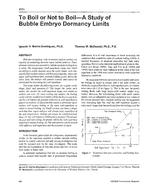Description
With few exceptions, only re-entrant surface cavities are capable of containing dormant vapour bubble embryos. These dormant embryos are essential to initiate nucleate boiling from a cavity. The temperature (wall superheat) range over which an embryo is stable depends upon the cavity shape, neck size, and the fluid surface tension and thermal properties. Above the upper wall-superheat limit, nucleate boiling occurs. Below the lower limit, the embryo will quench (vanish) and cannot be reactivated by increasing the wall superheat. Presents the following points, for a given cavity shape, fluid, and pressure. 1) The larger the cavity neck radius, the smaller the wall-superheat range over which an embryo can exist. 2) Upon cooling any surface, the boiling cavity with the smallest neck radius will be the first to stop boiling but will require the greatest reduction in wall superheat to quench its embryo. 3) Each site that retains a (dormant) vapour embryo will resume boiling at the same wall-superheat at which it ceased boiling. 4) Small cavities can have a shape such that their vapour embryos will always exist, regardless of the wall temperature. Boiling can always be reinitiated from them. 5) Any wall subject to boiling has a memory! The greater the past wall-subcooling, the greater will be the wall-superheat required to initiate boiling. 6) The wall memory can be erased with sufficient wall-superheat and the presence of vapour.
KEYWORDS: year 1997, Superheating, boiling, heat flow, bubbles, water, R11, refrigerants, walls, calculating, fluorocarbons
Citation: ASHRAE Transactions, Vol.103, Part 2, Boston 1997
Product Details
- Published:
- 1997
- Number of Pages:
- 8
- File Size:
- 1 file , 910 KB
- Product Code(s):
- D-16409




